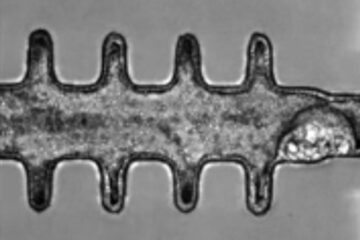DNA sequence controls expression of gene involved in cancer

Scientists have discovered a DNA sequence that causes the destabilization, and hence decay, of the protooncogene bcl-2 (B-cell lymphoma/leukemia-2). Because the overexpression of bcl-2 is associated with cancer, this discovery may lead to new therapeutic strategies for treating the disease.
The research appears as the “Paper of the Week” in the October 8 issue of the Journal of Biological Chemistry, an American Society for Biochemistry and Molecular Biology journal.
Bcl-2 is a gene that, when mutated or inappropriately expressed, can cause a cell to become cancerous. Normally, bcl-2 produces a protein that inhibits cell death or apoptosis. This protein keeps death-promoting factors from producing holes in the mitochondria which can result in calcium and destructive proteins leaking out into the cell. However, the overexpression of bcl-2 in damaged cells can lead to the continued division of the mutated cells and eventually cancer.
The expression of the bcl-2 gene is regulated both transcriptionally and posttranscriptionally. One way bcl-2 levels are controlled is through an adenine and uracil-rich sequence of nucleotides in the 3’ untranslated region of the bcl-2 mRNA. This sequence, called the AU-rich element, or ARE, recruits a number of proteins that destabilize the bcl-2 mRNA, resulting in its degradation.
A report that a region of RNA upstream of the ARE also affects mRNA stability motivated Dr. Jeong-Hwa Lee and his colleagues at the Catholic University of Korea to make a series of bcl-2 mRNA constructs with deletions around the ARE.
From these constructs, the investigators identified a region of 30 nucleotides outside the ARE that destabilizes bcl-2 mRNA both in the absence and in the presence of the ARE. Because the region is composed mostly of cytosine and adenine repeats, they named it the CA-repeated Region (CAR).
The discovery of a new region on the bcl-2 gene that controls its expression may be big news for cancer therapy. Several drugs that reduce the amount of bcl-2 present in the cell are already used in chemotherapy to induce apoptosis and overcome drug resistance in cancer cells.
Media Contact
More Information:
http://www.asbmb.orgAll latest news from the category: Life Sciences and Chemistry
Articles and reports from the Life Sciences and chemistry area deal with applied and basic research into modern biology, chemistry and human medicine.
Valuable information can be found on a range of life sciences fields including bacteriology, biochemistry, bionics, bioinformatics, biophysics, biotechnology, genetics, geobotany, human biology, marine biology, microbiology, molecular biology, cellular biology, zoology, bioinorganic chemistry, microchemistry and environmental chemistry.
Newest articles

Solving the riddle of the sphingolipids in coronary artery disease
Weill Cornell Medicine investigators have uncovered a way to unleash in blood vessels the protective effects of a type of fat-related molecule known as a sphingolipid, suggesting a promising new…

Rocks with the oldest evidence yet of Earth’s magnetic field
The 3.7 billion-year-old rocks may extend the magnetic field’s age by 200 million years. Geologists at MIT and Oxford University have uncovered ancient rocks in Greenland that bear the oldest…

Mini-colons revolutionize colorectal cancer research
As our battle against cancer rages on, the quest for more sophisticated and realistic models to study tumor development has never been more critical. Until now, research has relied on…





















